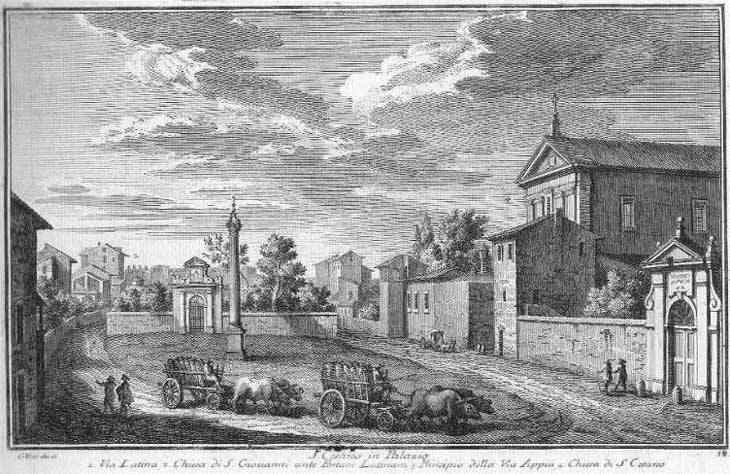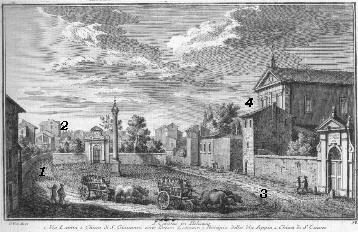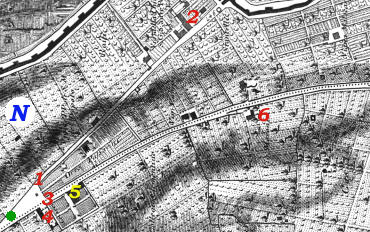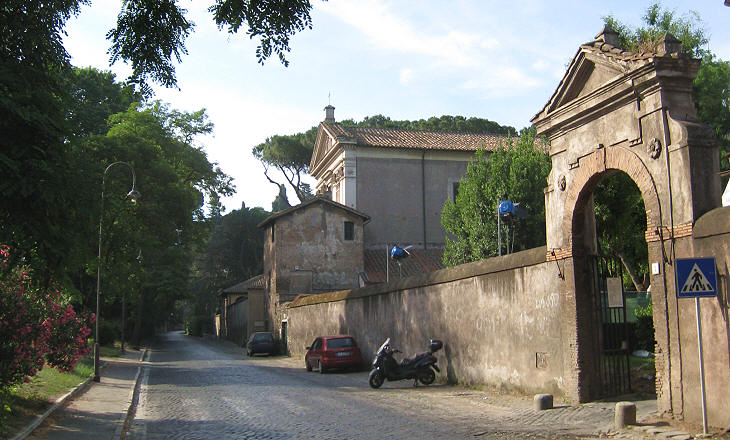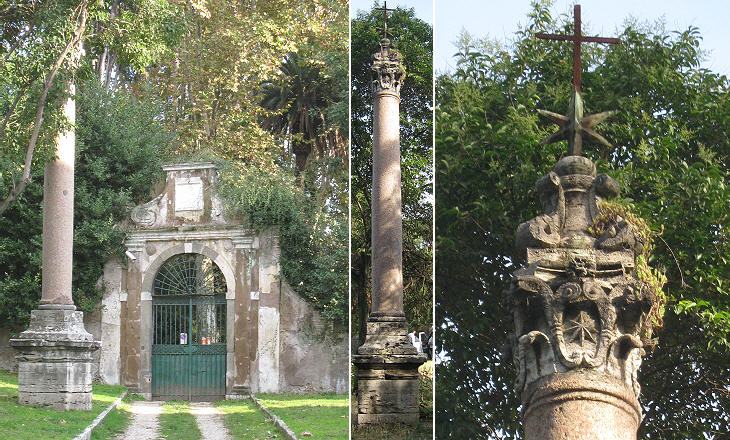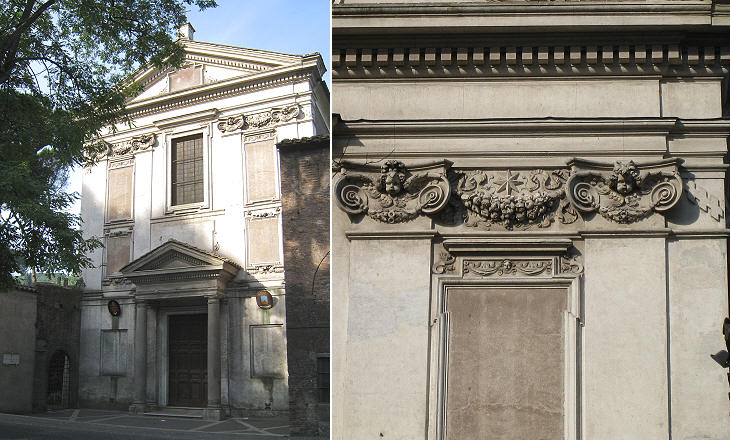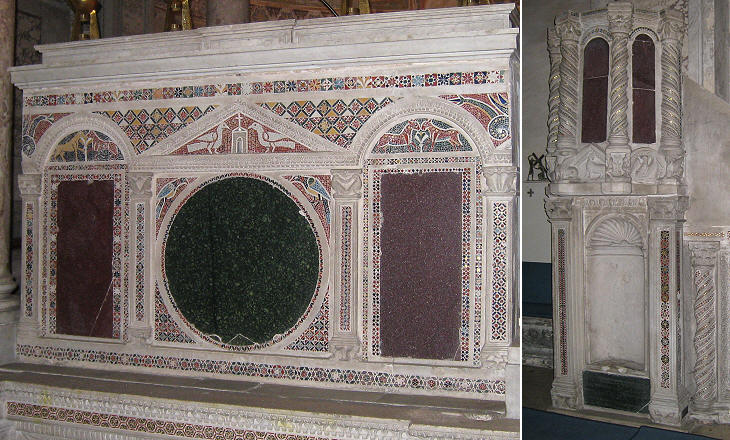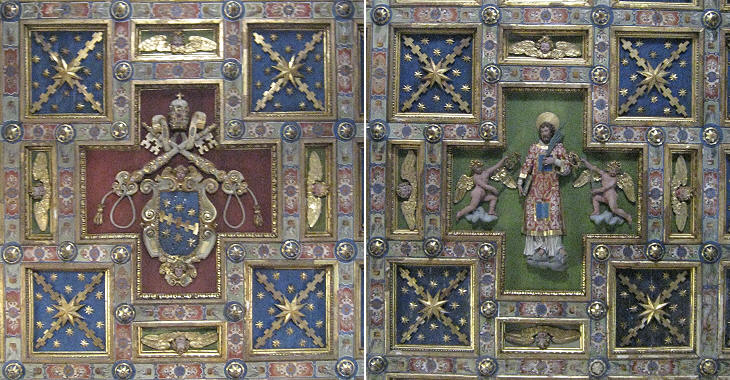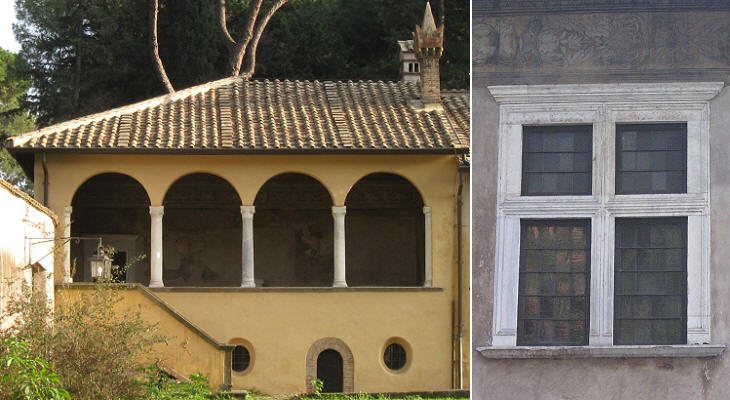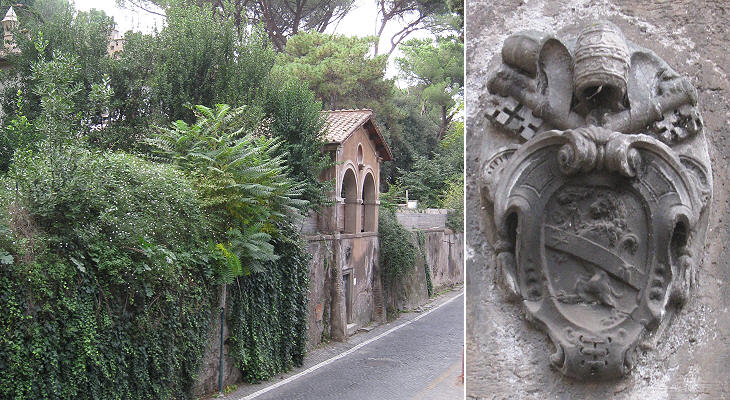  What's New! Detailed Sitemap All images © by Roberto Piperno, owner of the domain. Write to romapip@quipo.it. Text edited by Rosamie Moore. Page revised in November 2009. | S. Cesareo (Book 3) (Map B4) (Day 5) (View C10) (Rione Ripa)
In this page:
The plate shows the location where Via Latina on the left diverges from Via Appia on the right. We are inside the city walls, but at Vasi's time the area was almost unpopulated and the two ancient roads were used only by farmers who came to Rome to sell their products. The view is taken from the green dot in the small 1748 map here below. In the description below the plate Vasi made reference to: 1) Via Latina; 2) S. Giovanni a Porta Latina; 3) Via Appia; 4) S. Cesareo in Palatio. 2) is shown in another page. The small map shows also; 5) Villa Appia delle Sirene; 6) Casino del Cardinal Bessarione.
A few steps away from the location shown above a large avenue (Via Cristoforo Colombo) linking Rome with Eur (a modern quarter) is busy and noisy because of traffic congestion, but the site where Via Appia and Via Latina split is peaceful as at Vasi's time (at least on Sundays when the two streets are reserved to pedestrians).
The gate behind the column was the entrance to Vigna Passarini and it was decorated with a sacred image; this has been replaced by the inscription "Horti Galateae", the name given to the garden beyond the gate by Giulio Aristide Sartorio (1860-1932), an Italian painter and film-maker. S. Cesareo
The small square in front of S. Cesareo is empty and silent. The old church was restored by Cardinal Cesare Baronio during the pontificate of Pope Clement VIII and it was decorated with the heraldic symbols of the pope which were placed also on the capital of the ancient granite column opposite the church. Cardinal Baronio was the titular of nearby SS. Nereo ed Achilleo. Below the floor of the church archaeologists have found evidence of an ancient building and traces of a mosaic very similar to that found in Terme di Nettuno at Ostia.
The interior of the church contains some fine Cosmati works; they are the result of assembling elements of different origin; it is thought that they might come from the transept of S. Giovanni in Laterano, the medieval decoration of which was renovated at the same time as S. Cesareo was restored.
The origin of the name of the church is uncertain; it probably derives from Aedes Caesarum in Palatio, meaning palaces of the emperors on the Palatine; a lost church called S. Cesareo in Palatio was built near S. Sebastiano al Palatino and eventually the name was attributed to this church. Cardinal Cesare Baronio is known for having written Martyrologium Romanum, a revised list of the saints which was endorsed by the pope. Although historical evidence on S. Cesareo was very slim, the cardinal, maybe not to displease the inhabitants of Terracina, a town of the Papal State where Cesareo was born, confirmed S. Cesareo as a saint. From Martyrologium Romanum - Sanguis Martyrum Semen Christianorum: Tarracinae, in Campania, natalis sancti Caesarii Diaconi, qui, diebus multis in custodia maceratus, postea, cum sancto Iuliano Presbytero, in saccum missus et in mare praecipitatus est. (Terracina in the historical region of Campania, was the birthplace of St. Cesareo, a deacon who was kept in prison for many days and then, together with St. Giuliano presbyter, was placed in a sack and was thrown into the sea). It is interesting to observe that the association of Giuliano with Cesareo makes up Julius Caesar. Casino del Cardinal Bessarione
Basilios Bessarion, known in Italy as Giovanni Bessarione, was born in 1403 at Trebizond. When he became a monk he assumed the name of Bessarion, an Egyptian hermit. His life however was not that of a hermit. In 1439 he accompanied the Byzantine Emperor John VIII to the Council of Florence during which
the Orthodox and the Catholic churches reached an agreement over their different views on theological
matters. After the Council he
remained in Italy and he was appointed cardinal by Pope Eugenius IV. He spent his life trying to save as much as possible
of the Greek Byzantine heritage which included records of many works of the ancient philosophers. After the fall of Constantinople in 1453 he helped many Greek refugees.
Midway between S. Cesareo and Porta S. Sebastiano an unassuming door retains a well preserved coat of arms of Pope Sixtus V; the XVIth century building behind the high wall has a name full of mystery: Villa Appia delle Sirene (Sirene=Mermaids). The villa was part of Vigna Moroni where in the early XVIIIth century funerary chambers containing glassware and terracotta lamps were discovered. Many of the items were eventually purchased by Sir Hans Sloane and are now part of the British Museum collections. Excerpts from Giuseppe Vasi 1761 Itinerary related to this page:
Next plate in Book 3: Basilica di S. Sebastiano Next step in Day 5 itinerary: Porta Latina Next step in your tour of Rione Ripa: Bastione del Sangallo |
